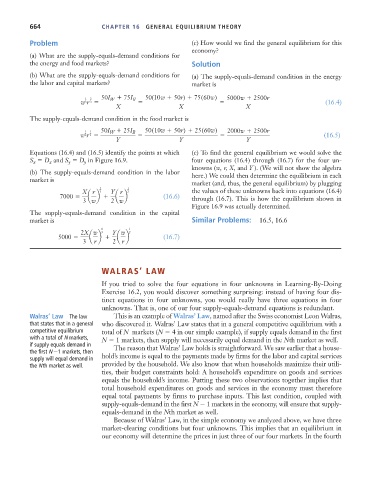Page 690 - Microeconomics, Fourth Edition
P. 690
c16GeneralEquilibriumTheory.qxd 8/16/10 9:13 PM Page 664
664 CHAPTER 16 GENERAL EQUILIBRIUM THEORY
Problem (c) How would we find the general equilibrium for this
economy?
(a) What are the supply-equals-demand conditions for
the energy and food markets? Solution
(b) What are the supply-equals-demand conditions for (a) The supply-equals-demand condition in the energy
the labor and capital markets? market is
50(10w 50r) 75(60w) 5000w 2500r
1 2 50I W 75I B
w r (16.4)
3
3
X X X
The supply-equals-demand condition in the food market is
50(10w 50r) 25(60w)
1 1 50I W 25I B 2000w 2500r
w r (16.5)
2
2
Y Y Y
Equations (16.4) and (16.5) identify the points at which (c) To find the general equilibrium we would solve the
S x D x and S y D y in Figure 16.9. four equations (16.4) through (16.7) for the four un-
knowns (w, r, X, and Y ). (We will not show the algebra
(b) The supply-equals-demand condition in the labor here.) We could then determine the equilibrium in each
market is
market (and, thus, the general equilibrium) by plugging
2 1
X r 3 Y r 2 the values of these unknowns back into equations (16.4)
7000 a b a b (16.6) through (16.7). This is how the equilibrium shown in
3 w 2 w
Figure 16.9 was actually determined.
The supply-equals-demand condition in the capital
market is Similar Problems: 16.5, 16.6
1 1
2X w 3 Y w 2
5000 a b a b (16.7)
3 r 2 r
WALRAS’ LAW
If you tried to solve the four equations in four unknowns in Learning-By-Doing
Exercise 16.2, you would discover something surprising: instead of having four dis-
tinct equations in four unknowns, you would really have three equations in four
unknowns. That is, one of our four supply-equals-demand equations is redundant.
Walras’ Law The law This is an example of Walras’ Law, named after the Swiss economist Leon Walras,
that states that in a general who discovered it. Walras’ Law states that in a general competitive equilibrium with a
competitive equilibrium total of N markets (N 4 in our simple example), if supply equals demand in the first
with a total of N markets, N 1 markets, then supply will necessarily equal demand in the Nth market as well.
if supply equals demand in The reason that Walras’ Law holds is straightforward. We saw earlier that a house-
the first N 1 markets, then
supply will equal demand in hold’s income is equal to the payments made by firms for the labor and capital services
the Nth market as well. provided by the household. We also know that when households maximize their utili-
ties, their budget constraints hold: A household’s expenditure on goods and services
equals the household’s income. Putting these two observations together implies that
total household expenditures on goods and services in the economy must therefore
equal total payments by firms to purchase inputs. This last condition, coupled with
supply-equals-demand in the first N 1 markets in the economy, will ensure that supply-
equals-demand in the Nth market as well.
Because of Walras’ Law, in the simple economy we analyzed above, we have three
market-clearing conditions but four unknowns. This implies that an equilibrium in
our economy will determine the prices in just three of our four markets. In the fourth

